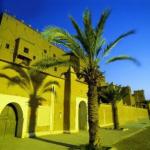Sights Rabat, Morocco
 Rabat is rich in historical sights. Here is one of the most remarkable monuments of antiquity - the unfinished tower of the mosque Tour Hassan (height 69 m).
Rabat is rich in historical sights. Here is one of the most remarkable monuments of antiquity - the unfinished tower of the mosque Tour Hassan (height 69 m).The history of the city can be read in its architecture. The most ancient part - Udayas Kasbah fortress, built on a rock. Certainly worth a look at the Mosque of Hassan (its construction was never completed) and the minarets of the Tower of Hassan »(XII century), the great mosque (which began to build in the XIV century, and later build on additional rooms).
In the XVII century the town was divided by a wall into two parts, the northern - Medina, and southern. In the next century was built the Palace of the King (the construction of the main building - the second half of XVIII century). No less beautiful and more modern structures, namely the mosque and the mausoleum of Mohammed V (created in the 1960's). Framed marble columns, the mausoleum of the king commands respect and deserves a detailed review. Among the tourists enjoy a variety of popular products of local artisans - carpets, hardware, fabrics, and various crafts. Walking along the sea coast, be sure to try the local fish, which fishermen on the grill right at your request with you. But at the same time, in this city and throbs with life. Undoubtedly, Rabat - the cultural and religious center of Morocco, here are the foreign embassies, is determined by the policy of the country. In Rabat, also located, and the University of Mohammed V, in which, for reviews of local residents, it is very difficult to do (and learn). That is why most of the Moroccan youth prefer to leave to study in Europe, Russia or America.
Nearby is the town of Rabat, Salé, united with him in one Prefecture. Connected to the bridge Rabat, Salé stores unique charm of a small Muslim village. Definitely worth a walk in his quiet streets and sunny squares, decorated with carved fountains.
The old part of town - Medina has a long history, covered with legends, and she lives the traditions, customs, and crafts. Here, hand knit lace, carpets, blankets, circular east poofs, copper and silver utensils. Moroccan carpets are famous all over the world.
In Medina resides exclusively Muslim population: craftsmen, tinkers, potters, shoemakers, peddlers greens, etc. Streets in Medina similar to the tracks, winding among low-growing houses, shops, mosques. Old and new parts of the city shares the wall, built in the XII century.